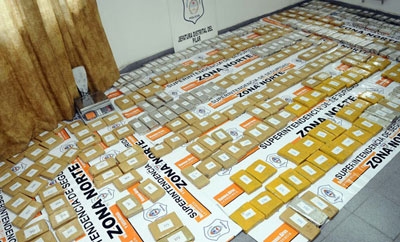Police in Buenos Aires broke the annual record for marijuana seizures in the province by the start of October this year, illustrating Argentina’s rise as a drug consumer, as well as transit and export nation.
Between January and September, police in Buenos Aires province seized more than 12 tons of marijuana, compared to 11 tons in all of 2012 and 8.5 tons the previous year, reported La Nacion.
These numbers are part of an overall trend in rising drug seizures across Argentina, where national police have discovered a record 54 tons of marijuana so far this year, which authorities say is destined for domestic consumption.
It also comes amid significant seizures of other drugs, with police in Buenos Aires province so far this year seizing more than a ton of cocaine, according to La Nacion, and uncovering an operation which produced and distributed party drugs such as ecstasy, ketamine and LSD.
The figure was released a day after a firefight between drug traffickers led police to the seizure of over 300 kilos of cocaine on the outskirts of the capital.
InSight Crime Analysis
The rise in drug seizures is the latest indication of Argentina’s growing role in South American drug trafficking networks. The country suffers from corruption and poor monitoring at some of its land border crossings, and functions as an important transshipment point for cocaine destined for Europe. The United Nations Office on Drugs and Crime (UNODC) 2013 World Drug Report (pdf) found Argentina was the third most common departure point for seized cocaine shipments.
Argentina has also been a refuge for major international drug traffickers, including former Urabeños leader Henry de Jesus Lopez, alias “Mi Sangre,” and allegedly by Sinaloa Cartel leader “El Chapo” Guzman. While it is unclear if Argentina appeals more as a refuge from law enforcement pressure in their home countries or as an opportunity to expand business interests, it is likely a combination of both.
See Also: Coverage of Argentina
In addition to this Argentina is one of the region’s biggest domestic drug markets. According to the UNDOC 2011 World Drug Report (pdf), Argentina is Latin America’s second-largest domestic cocaine market, after Brazil. It is also one of the primary destinations for marijuana from the region’s principal marijuana producer Paraguay, while the growth of the party drug market has also been reported over recent years,

